How do you make a non-alcoholic sangria that boasts just as much depth of flavor as the original? Simply steep tart hibiscus flowers with warming spices, fresh thyme, a touch of honey, and citrus. It’s a summer sipper you’ll enjoy all season long!
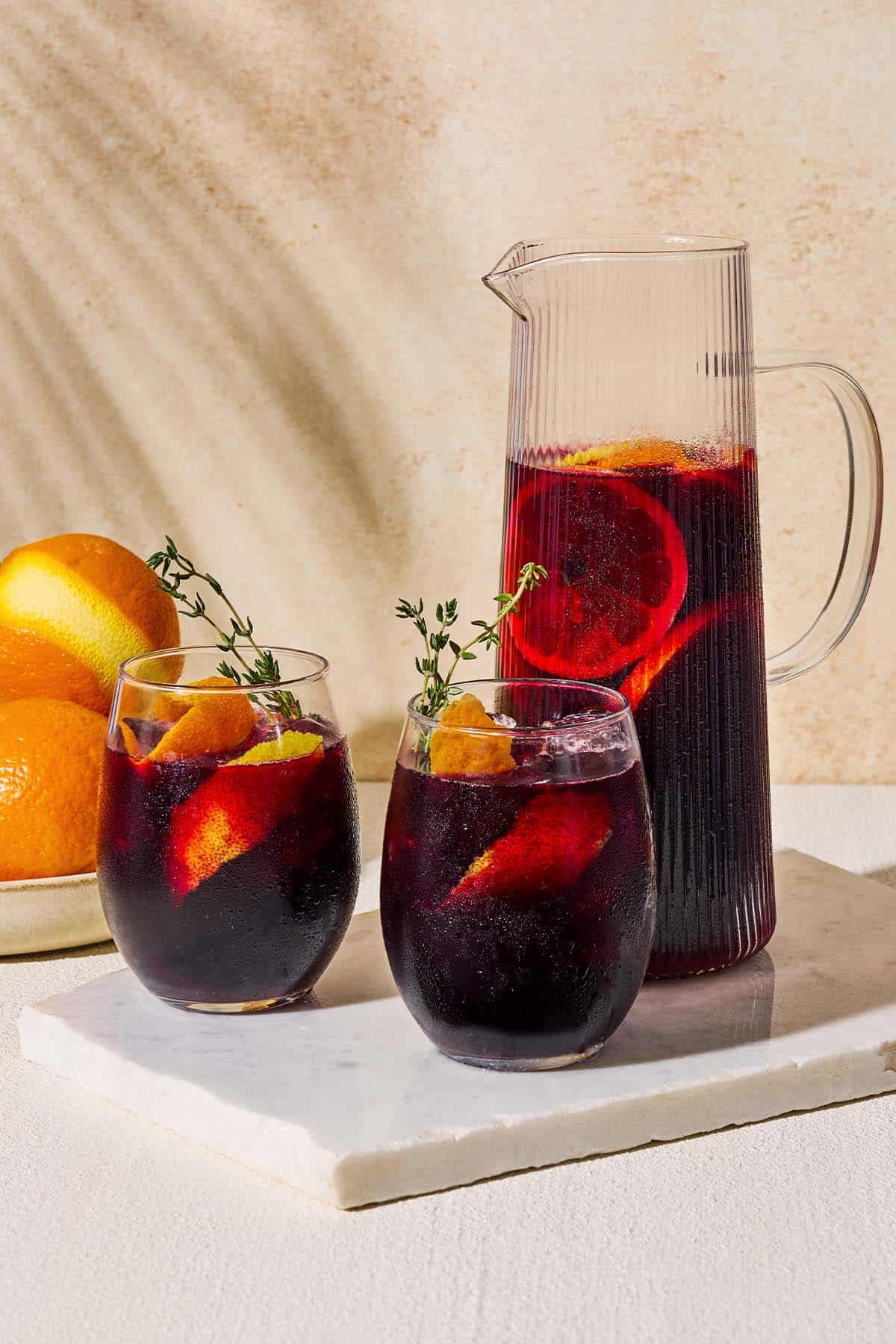
Layered with a balance of sweet, spicy, tart, and effervescent, this refreshing non alcoholic sangria is perfect for summer parties or brunches, especially for the non-drinkers, kiddos, or D.D.s! The base is a concentrate of dried hibiscus flowers, spices, honey, citrus zests, and fresh thyme. To get the body of a fine wine, I use a large amount of dried flowers, which gives it a thick and syrupy consistency.
That concentrate is infused with cloves, black pepper, allspice berries, and cinnamon, which is a nod to the notes you would find in the Spanish wine Rioja, making it feel even more authentic. This sangria mocktail could fool many aficionados into thinking it’s the real-deal traditional sangria!
As a bonus, this mocktail is sweetened with just a touch of honey and freshly squeezed orange juice. Making it healthier than many mocktail recipes that substitute alcohol for sugary sodas. Fresh thyme adds a herbaceousness for depth of flavor, and it’s all finished with slices of orange and lemon.
Make sure the glasses are ice-cold, and add a highly recommended (but optional) splash of club soda to make it extra refreshing, leaving a subtle fizz on the tongue just like a sparkling wine. Simply mix, then sit back, relax, and enjoy the “fruits” of your labor!
Table of Contents
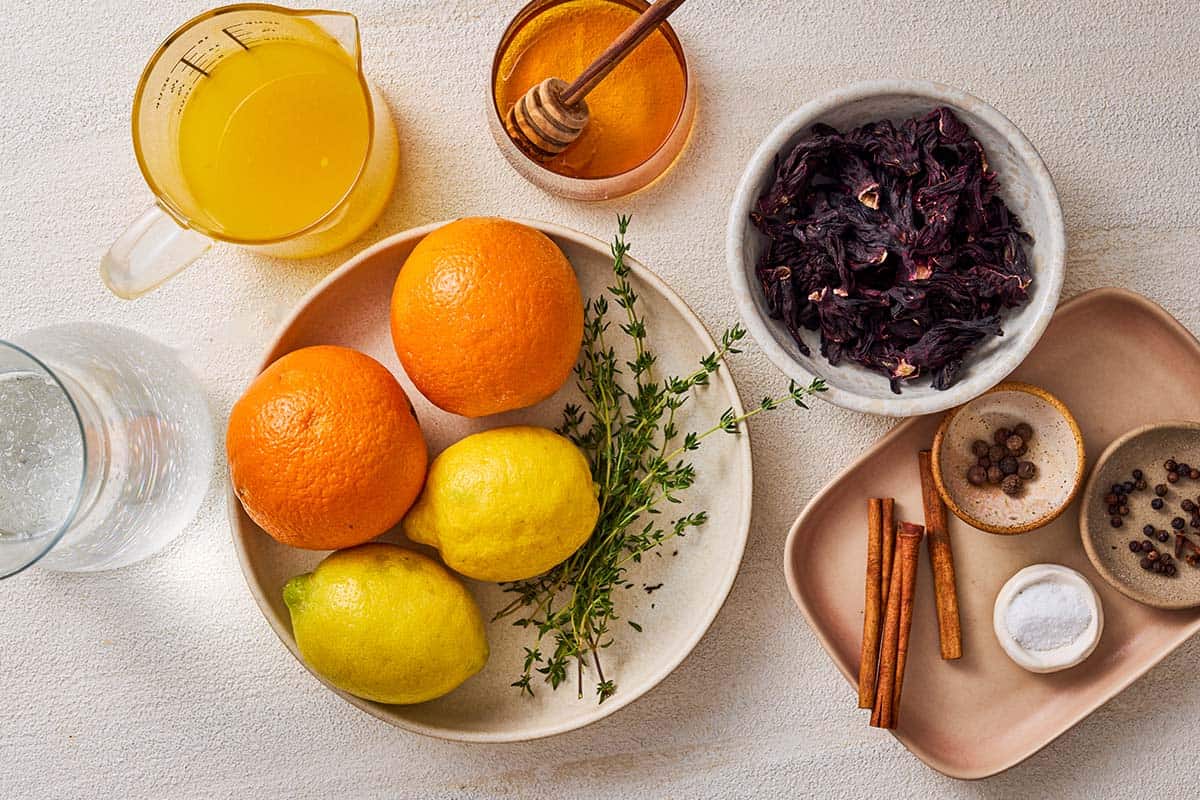
Non Alcoholic Sangria Ingredients
The ingredients in this sangria mocktail closely match the flavor profile of a regular sangria recipe.
- Orange zest adds an intense orange flavor and aroma.
- Lemon zest gives the concentrate a sharp citrusy flavor.
- Cinnamon sticks, allspice, peppercorns, and cloves bring the warming, spicy flavors you find in some Rioja wines.
- Fresh thyme sprigs are added to bring herbaceousness and elevate the peppery, clove flavor of the spices.
- Dried hibiscus flowers bring the sangria’s primary ‘red wine’ color and a tannic quality to mimic red wine.
- Honey balances the natural tartness of the hibiscus. Use a high-quality all-natural honey–head over to our shop to stock up on Greek honey or this lovely Italian Citrus Honey. Both are amazing in this mocktail recipe.
- Kosher salt is optional but always intensifies flavors, even in sweet dishes and drinks.
- Fresh orange juice brings additional sweetness.
- Lemon juice brings a sharpness and layer of complexity to the citrus notes .
- Sliced oranges and lemons add fruitiness—just like a traditional sangria.
- Club soda makes the drink even more refreshing, and similar to some wines that leave a fizz on the tongue!
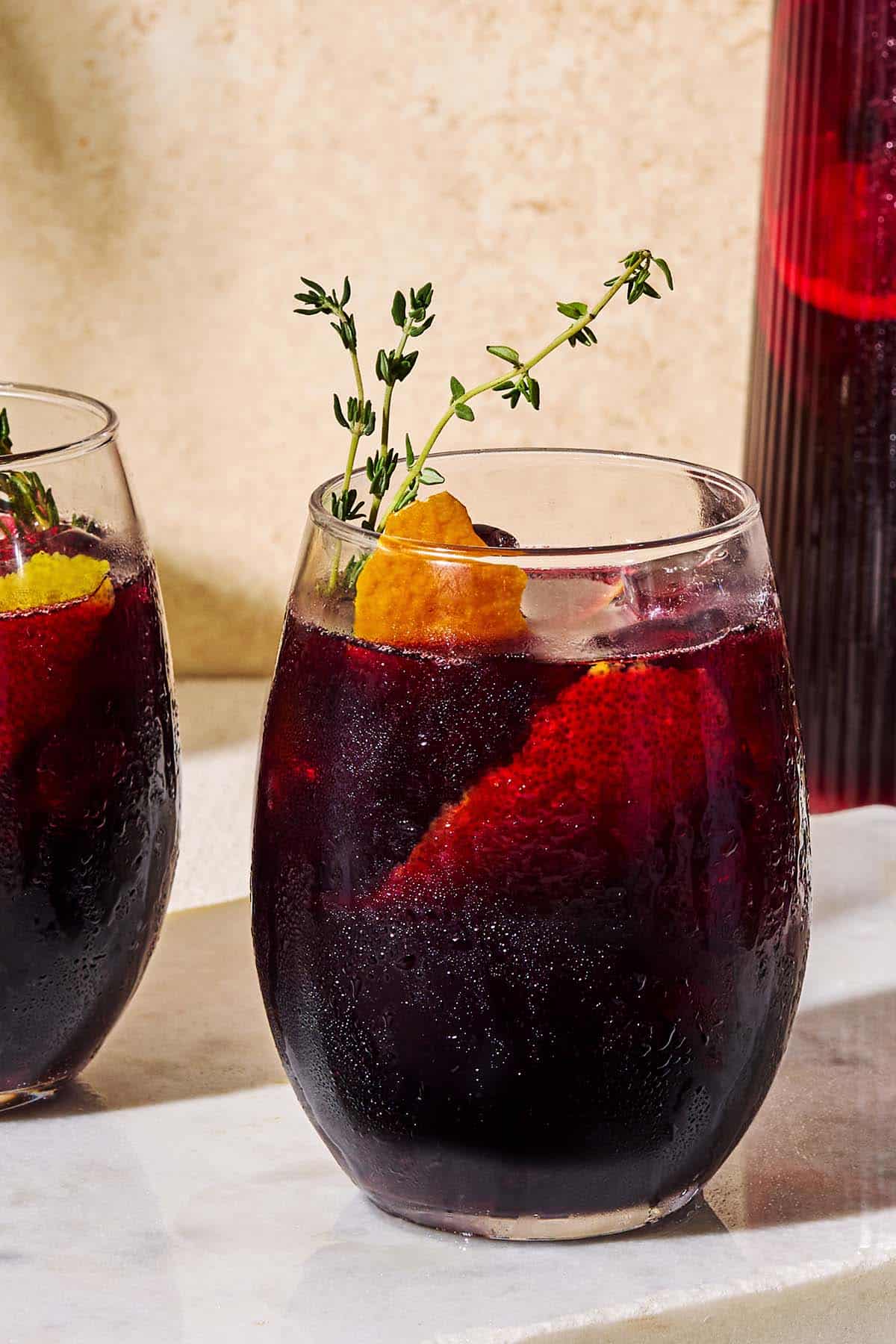
How to Make This Non-Alcoholic Sangria Recipe
This mocktail recipe is fairly easy, you just need to plan ahead. Give yourself at least two hours to get everything nice and chilled and flavorful. Or, if you’d like to make it the night before, hold off on the citrus slices until 2-4 hours before serving, as they can add bitterness if they steep too long. Here are the steps.
Steep and Juice
- Prepare the hibiscus syrup. Use a vegetable peeler to remove 2 long strips of zest from the orange and the zest from the entire lemon, leaving behind as much white pith as possible. Next, add the orange and lemon zest to a medium saucepan set over medium-high heat. To the pan add water, cinnamon sticks, thyme sprigs, dried hibiscus flowers, honey, allspice berries, cloves, black peppercorns, and salt (if using), and stir to combine.
- Simmer the syrup. Bring to a boil, then reduce heat to medium-low to maintain a low simmer for about 6 minutes, stirring occasionally to allow flavors to meld. Remove from heat and allow to cool to room temperature and steep for 1 hour. This gives the flavors and colors a chance to intensify.
- Prepare the pitcher. To a pitcher, add 1 cup orange juice and the orange and lemon slices (you may want to reserve a few orange and lemon slices to garnish the glasses). Into a liquid measuring cup, juice the zested orange. Set a fine mesh sieve over the pitcher and pour the orange juice through it to remove any pulp or seeds. Next, juice the zested lemon into the liquid measuring cup. Remove 1 tablespoon of lemon juice, and add it to the pitcher with the orange juice. Save the rest of the lemon juice for another day.
- Strain the syrup. Pour the cooled syrup through the fine mesh strainer into the pitcher with the juice (if your pitcher has a narrow top, you may want to do this into a spouted bowl first). Press the spices and strips of zest with the back of a spoon to squeeze out the maximum flavor. Discard the solids.
Strain, Chill, and Serve
- Strain the syrup. Pour the cooled syrup through the fine mesh strainer into the pitcher with the juice (if your pitcher has a narrow top, you may want to do this into a spouted bowl first). Press the spices and strips of zest with the back of a spoon to squeeze out the maximum flavor. Discard the solids.
- Chill. Stir to combine the liquids, then cover the pitcher and transfer to the fridge to chill for 2 to 4 hours—or up to overnight. (This is optional, but it does further deepen the flavor.)
- Serve. Pour into ice-filled wine glasses and garnish with reserved quartered orange slices, lemon wheels, and a small sprig of thyme, if desired. Top with a splash of club soda (if using) and stir to combine.
Ways to Make Non-Alcoholic Sangria Your Own
This sangria mocktail recipe is also easily adaptable, so you can swap out some of the ingredients to suit your taste, what’s available in your fridge or pantry, or what’s in season. Here are some ideas for alternatives and substitutes:
- Navel oranges: Substitute with any in-season orange, such as caracara, blood orange, or mandarins, to replace the zest, juice, and sliced navel oranges.
- Lemons: Substitute with limes instead.
- Whole Allspice: You can easily use ¾ teaspoon of ground allspice instead of using 18 whole allspice berries.
- Cinnamon stick: Use 2 ½ teaspoons of ground cinnamon to replace 3 cinnamon sticks.
- Cloves: Use ½ teaspoon ground cloves instead of ¾ teaspoon,
- Black peppercorns: Use a heaping ½ teaspoon of freshly ground black pepper.
- Fresh thyme: You could replace it with fresh mint sprigs, but if serving this during winter, then you could replace the 3 large sprigs of fresh thyme with 1 large sprig of rosemary. Rosemary is a more overpowering flavor, so you only need one sprig.
- Orange and lemon slices: You could garnish with any fruit, such as sliced strawberries, chopped pear or apple, or even pineapple.
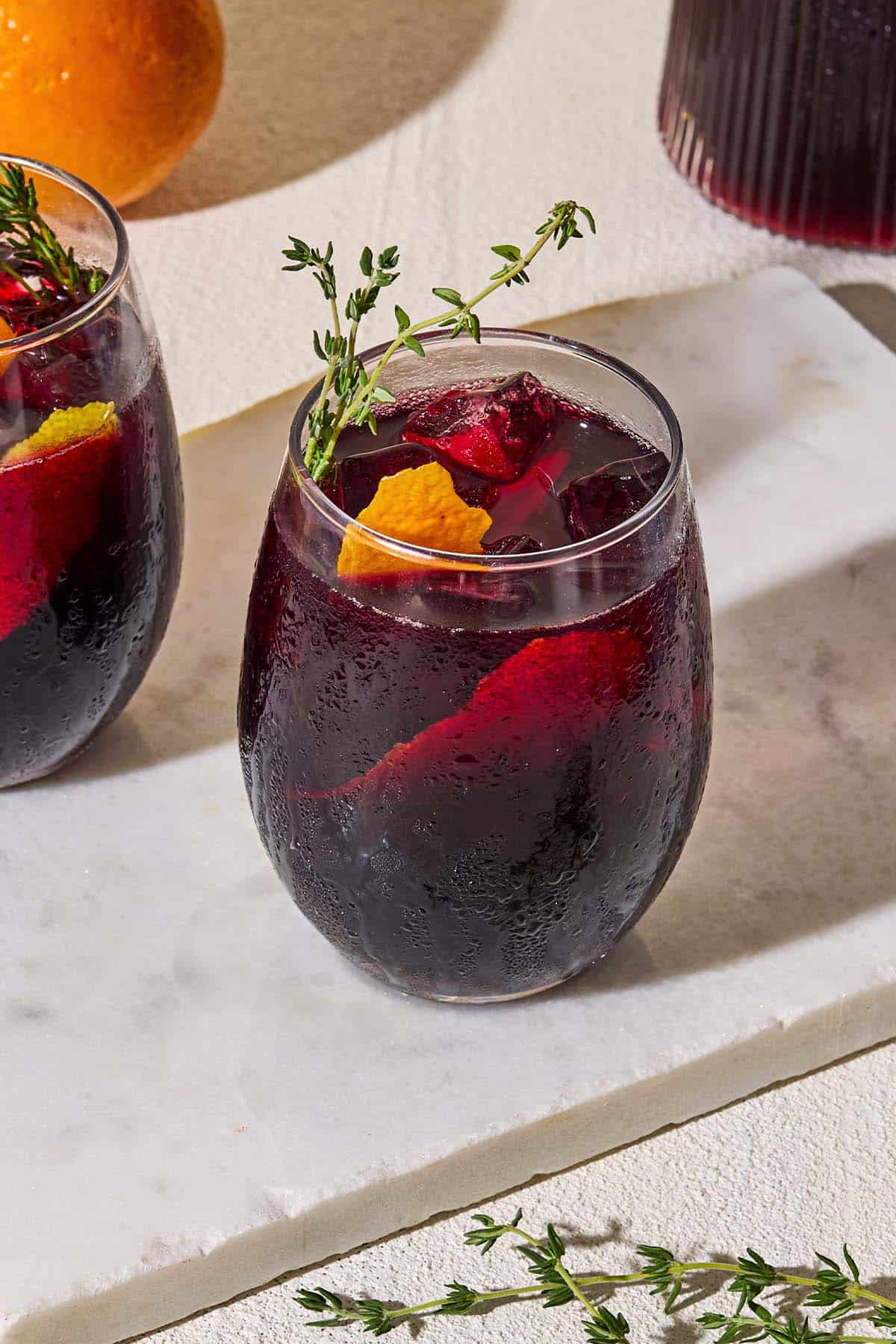
How to Make it Boozy
You could of course make a traditional sangria, and we have red sangria, white sangria, watermelon sangria, and holiday sangria recipes. But if you love the spiced hibiscus flavor of this recipe, or you want two matching pitchers to serve a big crowd:
- Replace the 6 cups of water with one (750ml) bottle of Rioja and 1 cup of water.
- Add a splash of brandy with the orange juice at the end.
- You will get a rich, citrusy, spiced hibiscus-flavored boozy sangria instead!
What to Serve with this Non Alcoholic Sangria Recipe
Thanks to its similar flavor profile to Rioja wine, this sangria mocktail is a versatile companion to many dishes. Its citrus and spice notes beautifully complement lamb or pork dishes, cutting through their richness.
Consider serving it with lamb Kleftiko, or Pork Chops with Bay Leaf and Lemon. It’s also an excellent match for tapas, such as Crispy Patatas Bravas or Pan Con Tomate.
Pitcher drinks like this booze-free sangria recipe are great for gathering so pair it with anything you’d feed a crowd or serve on a grill. Think Pork Souvlaki or Grilled Salmon. Cheers
More Alcohol-Free Sippers
Browse all Mediterranean recipes.
Visit Our Shop
Greek Honey – Thyme, Forest & Wild Herbs
Sweeten your mocktail with the highest quality honey from the Greek island of Crete.

Non Alcoholic Sangria with Hibiscus and Thyme

Ingredients
For the hibiscus syrup
- 1 navel orange
- 1 lemon
- 6 cups water
- 3 cinnamon sticks
- 3 sprigs fresh thyme, plus more for garnish
- 1 1/3 cup dried (about 50g) hibiscus flowers
- 1/3 cup (4 ounces) honey
- 1/2 tablespoon whole allspice berries
- 3/4 teaspoon cloves
- 1/2 teaspoon whole black peppercorns
- 1/4 teaspoon kosher salt (optional)
To finish and serve
- 1 cup orange juice, from 5 oranges
- 1 orange, quartered and thinly sliced
- 1 lemon, quartered and thinly sliced
- Ice
- Club soda (optional)
- 8 fresh thyme sprigs
Instructions
- Prepare the hibiscus syrup. Use a vegetable peeler to remove 2 long strips of zest from the orange and the zest from the entire lemon, leaving behind as much white pith as possible. Add the orange and lemon zest to a medium saucepan set over medium-high heat. To the pan add water, cinnamon sticks, thyme sprigs, dried hibiscus flowers, honey, allspice berries, cloves, black peppercorns, and salt (if using), and stir to combine.
- Simmer the syrup. Bring to a boil, then reduce heat to medium-low to maintain a low simmer, stirring occasionally, to allow flavors to meld for 6 minutes. Remove from heat and allow to cool to room temperature and steep for 1 hour. This gives the flavors and colors a chance to intensify.
- Prepare the pitcher. To a pitcher, add 1 cup orange juice and the orange and lemon slices (you may want to reserve a few orange and lemon slices for garnish). Into a liquid measuring cup, juice the zested orange. Set a fine mesh sieve over the pitcher and pour the orange juice through it to remove any pulp or seeds. Next, juice the zested lemon into the liquid measuring cup. Remove 1 tablespoon of lemon juice, and add it to the pitcher with the orange juice.
- Strain the syrup. Pour the cooled syrup through the fine mesh strainer into the pitcher with the juice (if your pitcher has a narrow top, you may want to do this into a spouted bowl first). Press the spices and strips of zest with the back of a spoon to squeeze out the maximum flavor. Discard the solids.
- Chill. Stir to combine the liquids, then cover the pitcher and transfer to the fridge to chill for 2 to 4 hours—or up to overnight. (This is optional, but it does further deepen the flavor.)
- Serve. Pour into ice-filled wine glasses and garnish with reserved quartered orange slices, lemon wheels, and a small sprig of thyme, if desired. Top with a splash of club soda (if using) and stir to combine.
Notes
- Shop this recipe: Visit our shop to browse quality Mediterranean ingredients including the honey used in this recipe.
- If you are chilling the sangria overnight, I recommend keeping the citrus slices separate until 2-4 hours before serving. This will prevent the lemon slices causing any bitterness.
- Be mindful that hibiscus can stain porous or light surfaces. I’ll learn one day! 🙂





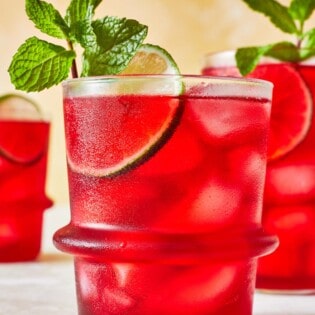
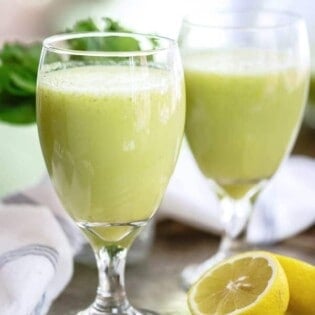
Do you have any suggestions for a substitute for the orange juice? I really want to make this, but my husband is allergic to oranges.
Hi, Tammy! I’m Summer and I work here at The Mediterranean Dish. I think you could swap in pineapple juice, it would be sweeter, but still good. Or try a mango. You could also try pomegranate juice or a blend. Really any fruit juice would go well as long as it’s 100 percent juice.